#ishtar deity
Text

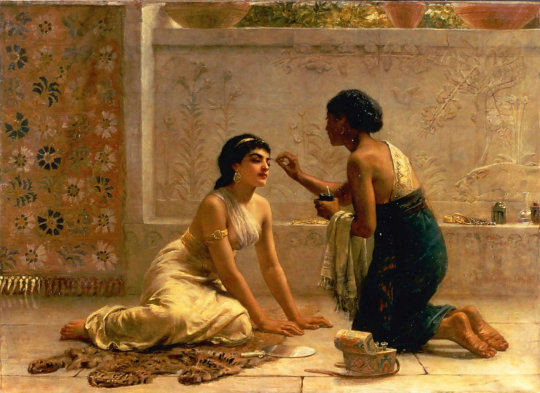


e-offering to Inanna-Ishtar #001
#devotion#inanna ishtar#goddess spirituality#goddess worship#inanna deity#ishtar deity#love witch#glamour witch#witchblr#dark divine feminine#dark goddess#theglamourempress
78 notes
·
View notes
Note
if you’re still doing tarot reading requests I’d like to ask for some clarity on whether or not Ishtar is calling to me? Reaching out to work with me?🌹🕊 thank you♥️
I know this is super late on my part, so hopefully you will see this if you're still curious and looking for an answer.
I pulled the Six of Wands, the Queen of Wands, and The Fool. The first two cards represent Ishtar, what she brings to others as a goddess of fertility, war, rain, and thunderstorms. She comes with abundance, pride, success, and confidence as a deity known to give and take. What she gives is her hand as she reaches out to you, and what she asks for is you taking a chance and follow what you want and feels comfortable for you. As the Queen of Wands pushes, she is a strong and confident deity who wants to say that the choice is ultimately yours, as it is with every deity. The options are open, and The Fool is what can come with this choice as a new turn (beginning) in your life. Where would anyone get if not taking the step forward regardless of what could happen, taking chances and chasing desires instead of letting opportunities slip through one's fingers. Take control of the moment and grab her extended hand if it speaks to you and the idea of having a relationship resonates with you and is exciting to think about.
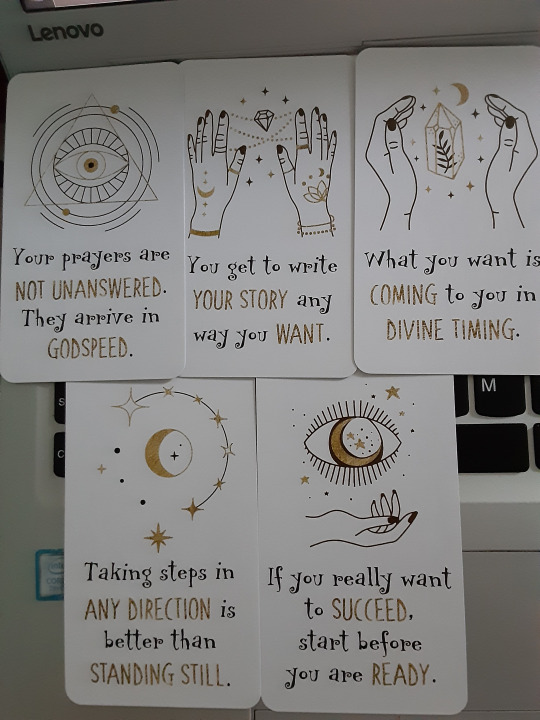
Followed by my backup oracle reading to reaffirm and aid in the message of the tarot reading, reach for the stars, and who knows what amazing things will quickly follow.
2 notes
·
View notes
Text


Worship a primordial Goddess of Liberation ✴️
Worship a primordial Goddess who helps you to experience pleasure to experience yourself,
who does not shame you for enjoying sex, who wants you to experience joy and love without shame or stigma- love for others as well as love for yourself.
Who’s eyes never falter, judge, or look down upon, who never discriminates, who is blind to prejudice, who never sees your desires as gross or unholy, who values your quirks and desperate habits, your urges and desires, who knows your need for love, kindness, and tenderness.
Worship a primordial Goddess who cheers for you every day, who sees you as a divine creature- a god- in yourself. Who treats you as an equal and respects you as a good friend. Who will never force you to abandon what you love or snuff your shining flame. Who will nurture you as you bloom into your most perfect self,
Worship a primordial Goddess who you were not forced to worship, but who you came to in honesty and love and chose to worship because you wanted to. Worship a primordial Goddess who will never force you to do anything, but guide you with wisdom and intuition. Who will not threaten you, but you praise you,
who will protect you viciously, and show all who wish you harm the holy wrath of a mother’s love,
who values your expression as an act of love, who admires your sexuality and gender as divine elements of the human experience.
Worship a primordial Goddess who values your orgasms, who gains joy from your satisfaction and relief, who laughs when you laugh,
who sees sex not only as a means to procreate, but to know oneself and their partner(s) in a most intimate and delicate way.
Worship a primordial Goddess who respects and understands your kinks, who understands how your body has stored your trauma and celebrates your bravery in exploring those things in a healthy and safe environment.
Worship a primordial Goddess who dances and drinks and indulges in sweets and sex, who understands that we are here to experience joy and love, who asserts that happiness and freedom are not sins, but the most powerful things we have in this world.
Worship a primordial Goddess who wants you to live and love and laugh without shame,
who wants you to live
truly live
your best most delicious life.
Worship Inanna, Give Glory to Venus. Hail the Queen of Heaven! ✴️
Happy Venus day! :)

#witchcraft#magick#occultism#witch community#demonology#pagan#paganism#witch aesthetic#witchblr#grimoire#venus#inanna#ishtar#luciferian witch#theistic luciferianism#aphrodite#deity witchcraft#deity work#deity worship#deity
132 notes
·
View notes
Text
Gold Tablet from the Temple of Ištar in Aššur, Assyria (modern-day Iraq) c.1243-1207 BCE: this tablet was discovered within the foundations of the ancient temple; it measures just over 3cm (1in) in length
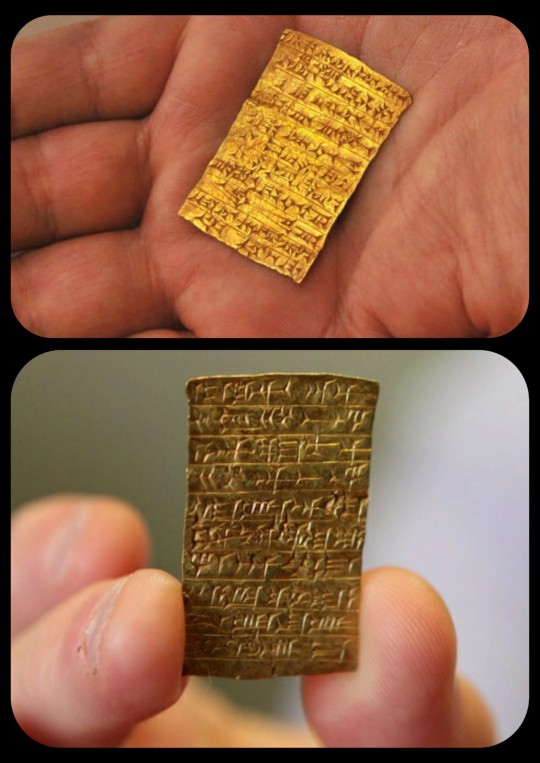
The cuneiform inscription honors King Tukulti-Ninurta I, who had ordered the construction of the temple, and describes how the building was constructed. This is just one of the many items that had been buried around the temple with similar inscriptions.
As this article explains:
Most of [the inscriptions installed in the temple] would not have been visible while the temple was still in use, as they were laid into the sanctuary’s foundations or walls. Tukulti-Ninurta commissioned a great number of objects carrying variations of the inscription commemorating his achievement of erecting the new temple.
The practice of depositing inscriptions directed at the gods as well as future generations had become a central element of the temple building process since the Early Dynastic Period, and was employed to immortalize the ruler by eternally associating his name with a monumental building such as the Ištar temple - a process that also transformed a sanctuary into a votive object dedicated to a deity.
It took several hours of searching (i.e. scouring through old artifact catalogs) for me to find a direct translation of the inscription on this particular tablet, and I could basically only find it in a PDF of an old bibliographic manuscript that isn't even in print anymore, but here it is:
Tukulti-Ninurta, king of the universe, king of Assyria, son of Shalmaneser, king of Assyria: at that time the temple of the goddess Ištar, my mistress, which Ilu-šumma, my forefather, the prince, had previously built — that temple had become dilapidated. I cleared away its debris down to the bottom of the foundation pit. I rebuilt from top to bottom and deposited my monumental inscription. May a later prince restore it and return my inscribed name to its place. Then Aššur will listen to his prayers.
This tablet was stolen from the Vorderasiatisches Museum in Berlin back in 1945, during the chaotic final days of WWII. It was then lost for almost 60 years before it finally re-emerged in 2006, when a Holocaust survivor named Riven Flamenbaum passed away and the tablet was found among his belongings. According to his family, Flamenbaum had gotten the tablet from a Soviet soldier (in exchange for two packs of cigarettes) at the end of the war.
In 2013, following a lengthy legal battle between Riven Flamenbaum's family and the Vorderasiatisches Museum in Germany, a court in New York ordered the family to return the tablet back to the museum.
Sources & More Info:
Albert Kirk Grayson: Assyrian Rulers of the Third and Second Millennia BC (to 1115 BC) (the translation appears on p.261)
Daniel Luckenbill: Ancient Records of Assyria and Babylonia, Volume 1 (PDF download; p.65 contains relevant info)
CTV News: 3,000-year-old Assyrian Gold Tablet Returned to German Museum
#archaeology#history#anthropology#ancient history#assyria#mesopotamia#golden tablet#cuneiform#artifact#ancient iraq#iraq#ancient near east#middle east#ishtar#pagan deities#polytheism#return the slab
346 notes
·
View notes
Text
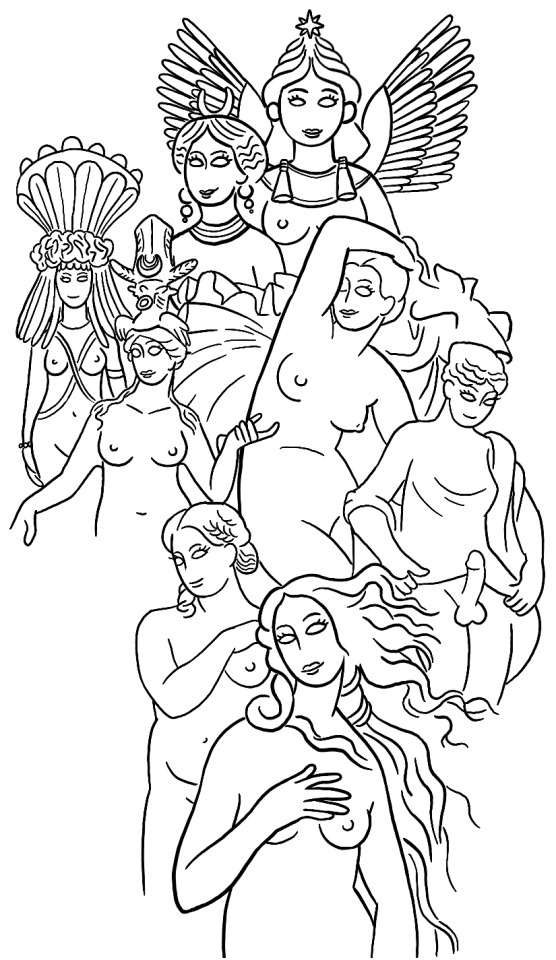
Aphrodite in all her aspects
#aphrodite#venus#ishtar#inanna#astarte#aphroditus#aphrodite urania#aphrodite pandemos#venus genetrix#aphrodite isis#aphrodite hathor#goddess#deity#paganism#greek mythology#mythology#deities#Phoenician#sumerian#akkadian#assyrian#roman#greek#babylonian#sketches
1K notes
·
View notes
Text


The Ishtar Gate in the Pergamon Museum in Berlin.
#Ishtar Gate#photography#eighth gate#inner city#babylon#history#Hillah#Babil Governorate#iraq#king Nebuchadnezzar II#structure#glazed bricks#bricks#blue#art#animals#deities#colored bricks#low relief#Robert Koldewey#berlin#Pergamon Museum#dragons#gate
17 notes
·
View notes
Text
Prayer to Mother Mary
Our Lady; Queen of Heaven; Mother of All.
Great Mary, from the Lineage of Hera, Inanna, Ishtar, and Astarte.
Help the people in the Palestine-Israel war, and the Ukraine-Russia war.
Our Lady, Queen of Peace.
Help them.
Hear their prayers.
Hear their cries, O lady of Sorrows.
Hold them under your Starry Mantle.
Keep civilians safe.
#our lady of fatima#our lady of sorrows#war tw#israel palestine war#great goddess#mother god#mother goddess#the goddess#queen of heaven#queen of peace#our lady of peace#hera deity#inanna#ishtar#astarte#religions#folk magic#cunning folk#folk magick#english folk magic#folk catholicism#christian witchcraft#mother of all#holy mother#mothergoddess#mother mary#heavenly mother#hellenic prayer#prayer
14 notes
·
View notes
Text
Happy Beltane: Celebrating Fire, Fertility, and the Triumph of Summer
Beltane, also known as Bealtaine or Cétshamhain (meaning “first of summer” in Irish), is one of the most vibrant fire festivals steeped in Celtic tradition and history.
It marks the halfway point between the spring equinox and the summer solstice, traditionally celebrated on May 1st.
On this day, the veil between the worlds is believed to be the thinnest, allowing for a heightened connection…
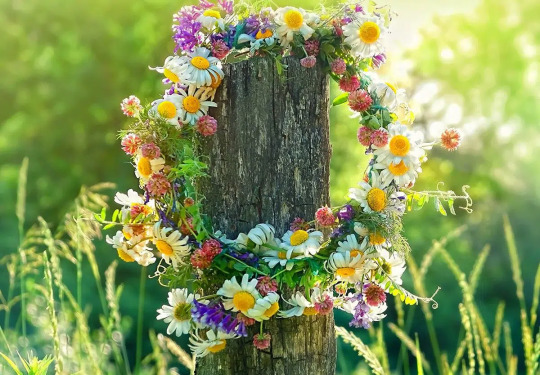
View On WordPress
#Altar#Beltaine#Beltane#Bonfire#Brigid#Cétshamhain#Celts#cleanse#conjure#connection#cycle of life#deity#demon#Esoterism#feast#Fertility#Flora. the Green Man#Gaelic#Harvest#invoke#Ireland#Ishtar#Isle of Man#May 1st#May Day#Maybush#Maypole#nature#pagan#Pagan Celebration
9 notes
·
View notes
Text
Ereškigal in Ancient Literature
*How to use the Internet Archive
🥀 Main Character 🥀
Earlier version of The Myth of Nergal & Ereškigal is available in the paper: New Readings in the Amarna Versions of Adapa and Nergal and Ereshkigal by Shlomo Izre'el.
The later version of the Myth of Nergal & Ereškigal, as well as a version of Ištar's Descent Into The Netherworld are both available in The Ancient Near East: An Anthology of Texts and Pictures edited by James A. Pritchard. Internet Archive full book.
Inanna's Descent into the Netherworld on the ETCSL.
Ištar's Descent into the Netherworld an audio of the myth spoken in Akkadian with an English text translation from 2005 and the most literal translation on the CDLI click "text"
🥀Other Mentions🥀
[Cut in case I need to add more if I find them]
Ningishzida's Journey to the Netherworld on the ETCSL ends with 'Great holy one, Ereškigal, praising you is sweet.'
The Underworld Visions of an Assyrian Prince available via Oracc Line 30 mentions Allatu (a Goddess Ereškigal was equated with). In line 35 Ereškigal tells a man in a dream that she saw his offering and he should pray to her so she would fufill his desires. In line 38 the man prays to Ereškigal and cries in front of Nergal described as King. In line r32 the man praises Nergal and Ereškigal to "peoples of Assyria"
Gligamesh Enkidu and the Netherworld on the ETCSL, in lines 1-26 & lines 91-113 Ereškigal is "given" the netherworld as a gift to rule or as a dowry depending on the academic you ask. In lines 199-204 she has an unflattering description given of her that is similar to a description of her in Inana's Descent▪️...Some personal thoughts: The description in Inana's Descent seems to have been written because she is lamenting. At the beginning of the myth she is sitting on a throne and not described unflatteringly in line 165-172; but later on in lines 226-235 & lines 254-262 she is described unflatteringly as laying down and lamenting the death of her unnamed children— "The mother who gave birth, Erec-ki-gala , because of her children, was lying there." In addition lines 236-245 & lines 263-272 she's described as troubled with a painful heart & liver. She appreciates the gala-tura lamenting with her. Recently found Diana Katz describing Ereshkigal as a "mourning mother," so I feel validated in my original assumption. Why the unflattering description is used in this myth I don't know, shes pulling out her hair which is a sign of lamenting but it seems out of place here? Unless the author is just saying shes ugly.
Death of Gilgamesh on the ETCSL, the Nibru version line 8 Gilgamash gives his first gifts to Ereškigal, in the Me-Turan version segment K the story closes with 'Ereškigal, mother of Ninazu, sweet is your praise'
The Death of Ur-Namma on the ETCSL. In the Nippur Version, in lines 92-96 Ereškigal is mentioned as loving weapons, In lines 97-101 she is given gifts from Ur-Namma. In lines 132-144 Ereshkigal's commands certain people "all the soldiers who had been killed by weapons and all the men who had been found guilty" to be given to the king Ur-Namma as his sits on a throne in the netherworld. In the Susa version she is also given gifts in line 29-92 and also at her command she hands over certain men in lines 64-72.
-Dyslexic not audio proof read-
#ereshkigal#Ereškigal#mesopotamia#sumerian#akkadian#ancient#ancient literature#ancient history#gods#deities#deity#Diĝir#inanna#inanna's descent#mythology#nergal#ishtar#ištar#gilgamesh#Ningishzida#enkidu#myqueen#i made this for another post but decided to split it#Ereškigal deity#ereshkigal deity#deity resource#resources#source
17 notes
·
View notes
Text
15 Essential Deities in Egyptian Mythology
Ancient Egyptian mythology is one of human history’s oldest and most fascinating belief systems. With a pantheon of gods and goddesses representing various aspects of life and the universe, the Egyptians created a rich and complex mythology that continues to captivate people today.

Here are some of the most significant Egyptian deities and what they represent:
Isis: Known as the “mother goddess,” Isis was associated with motherhood, fertility, and magic. She was also revered as the goddess of nature and healing.
Ma’at: As the goddess of truth, justice, and balance, Ma’at was an important figure in Egyptian mythology. She was responsible for maintaining the universe’s balance and upholding the laws of morality and ethics.
Ptah: Ptah was the god of craftsmen and creation, responsible for creating the universe and all living beings. He was also considered a protector of artists and artisans.
Osiris: One of the most important gods in Egyptian mythology, Osiris was the god of the underworld, fertility, and resurrection. He was believed to have been the first pharaoh and was responsible for teaching humanity about agriculture and civilization.
Seth: As the god of chaos and the desert, Seth was powerful and often feared figure in Egyptian mythology. He was also associated with storms, war, and violence.
Bastet: Known as the goddess of cats, Bastet was also associated with fertility, music, and dance. She was believed to protect homes and families from evil spirits and was often depicted with the head of a cat.
Thoth: Thoth was the god of wisdom, writing, and knowledge. He was responsible for inventing hieroglyphs and was believed to have written influential religious texts, like the Emerald Tablet.
Horus: As the god of the sky and kingship, Horus was an important figure in Egyptian mythology. He was believed to be the son of Osiris and Isis and was associated with the pharaohs of Egypt.
Sekhmet: Known as the goddess of war and healing, Sekhmet was often depicted as a lioness. She was believed to have the power to create and destroy and was called upon for protection during times of war.
Amun: Amun was the gods’ king and was associated with the sun and air. He was often depicted with a ram’s head and considered one of the Egyptian pantheon’s most potent and influential gods.
Ra: As the god of the sun and creation, Ra was a central figure in Egyptian mythology. He was believed to have created the world and was associated with the pharaohs of Egypt.
Hathor: Hathor was the goddess of love, beauty, and joy. She was associated with motherhood and fertility and was often depicted as a cow.
Nut: As the goddess of the sky, Nut was often depicted as a woman arching over the earth with her hands and feet touching the ground. She held up the stars and was considered a protector of the dead.
Geb: Geb was the god of the earth and was responsible for giving life to plants and animals. He was often depicted as a man lying on his back, with his wife Nut arched over him.
Khnum: Khnum was the god of creation and was associated with the Nile River. He was often depicted as a man with the head of a ram and was responsible for shaping humans out of clay.
Ancient Egyptian mythology features numerous intriguing deities, each symbolizing different life and universe elements. Even now, their tales remain captivating to many.
Keep exploring: 15 Essential Deities in Egyptian Mythology.
As you explore the world of Egyptian mythology, you may find yourself drawn to a particular deity and feel a connection to their power and energy. If that is the case, consider wearing a symbolic necklace as a reminder of its significance in your life.
A beautifully crafted necklace featuring an Egyptian deity can be a meaningful accessory that adds a touch of mystique to any outfit.

Wear a piece of Egyptian mythology with you wherever you go!
#egypteveryday#ancient egypt#ancient world#egyptian mythology#thoth tarot#apollotarot#magick#witches#myhtology#statement jewelry#egyptian gods#egyptian deity#egyptian deities#egyptian goddess#eclectic pagan#paganism#pagan#pagan worship#isis ishtar#horus#occult art#occultism#esoteric
39 notes
·
View notes
Text

This painting, Lili Marberg as Salome, inspired my most recent post for my Belladonna tier 🥀
I explore Salome & Herodias, as well as Persephone & Ishtar:
The Dark & Demonized Feminine is now available
Become a Patron only $6.66 🥀
#Femme fatale#Dark Goddess#Dark divine feminine#Ishtar deity#Persephone deity#Goddess spirituality#Patreon
45 notes
·
View notes
Text
do you ever think about how the first ever goddess mentioned in history is Ishtar, the mesopotamian goddess of love?
#like#since the beginning of time#love has been one of the key parts of humanity#and i think thats beautiful#religion#ancient history#ancient religion#mesopotamia#ishtar#deities#history
4 notes
·
View notes
Text




Hail Inanna! Great shining Lady of Love and War, we praise you and hold you dearly in our hearts! Praise the lovely and vibrant Lord Lucifer, the illuminator and liberator of the children of Inanna!
Since I started taking up the role of Inanna’s devotee more seriously, she has visited me every morning in my dreams. She has been the most active and personal deity I have ever had the honour of worshipping. I hear her lovely song as she rises into the sky, every morning around 3-4am, her presence along with Lucifer’s will fill my room and permeate my dreams. Her warmth is welcoming, sweet and rich. A dancing drum and an orchestra of beautiful singing voices will creep into my ears until I see her realm in my dreams. She is a smiling and dancing joyous God. I am among her and her children and we are together and in love. I am beyond lucky that she has taken the time to come to me so consistently.
She thanks me for loving Lucifer, for trusting and following him back to her, she thanks me for loving him all of her spirits. She thanks me for resting my body and praying to her. She asks me to show myself love today as an offering to her. She protects me into the morning and guides me into night. Thank you Great Lady of Heaven, thank you Lucifer! Hail Inanna! Glory to Venus! 🔱✴️🔱🖤
#witchcraft#magick#occultism#witch community#demonology#pagan#paganism#witch aesthetic#witchblr#grimoire#lucifer offering#luciferian witch#luciferian#theistic luciferianism#lucifer#inanna#ishtar#deity work#deity worship#deity witchcraft
80 notes
·
View notes
Text
Mother, Queen, Harlot
I feel the need to state that I am not a Thelemite and that my relationship and understanding of Babalon is informed mostly via direct contact with Her.
It was almost 10 years ago that I first felt Her presence. She would not give me a name but simply images, symbols, and emotions that represented her. I saw images of sex, blood, fire, blades, and serpents. Feelings of lust, love, passion, rage, sovereignty and feminine power.
Truth be told I wasn’t in the place to have a spirit like that be active in my life so it would be a few years before I set up a shrine to Her.
Her shrine was simple. An inexpensive goddess statue with a red costume rosary wrapped around it, a red candle, and a letter opener with a crown motif. I would burn incense and meditate on Her, sometimes seeking guidance, sometimes just simply being with her. I began referring to Her as “The Red Queen” while still not having a proper name. I was becoming comfortable with her ambiguity and in turn she was helping me become comfortable with myself.
It was around this time that I began working with a teacher who was helping me with visionary work and spirit flight. It was during one of our sessions that I made a breakthrough and came face-to-face with my Red Queen. She sat on a scarlet cushion in a rooms who’s lamps were draped with red scarves. Her hair was a deep brown almost black, her skin was an inhuman pale white. Her arm was casual laying across one upraised knee. She has gold bangles and armlets, gold anklets and rings, a gold hoop around her neck and in her ears, but ironically no crown. Her clothes were reminiscent of an Indian saree the colour of blood.
I sat across from her and bowed, placing my head on the cushioned floor. When I raised my head, she locked eyes with me.
“I am have many names, I am many. I am Ishtar, I am Innana, I am Lilith, I am the Queen of Heaven and Hell. But you, you will know me as Babalon.”
Thats when I returned to my body. I was flooded with joy and exhilaration, She had told me Her name, I had a better focus.
I knew that Babalon was a goddess in Thelema, but I knew next to nothing about Her other than that. To this day I still don’t really know much about her role in Thelema but I've been considering studying it. I’ve continued to go straight to Her when it comes to offerings, prayers, etc. Reading how others interact with her from time to time. Her shrine has grown but not by much, She’s comfortable with it being simple but beautiful. I have been searching for a new statue for Her though, something that I feel fits her better.
Babalon, The Red Queen, has been my strongest spiritual ally during my transition. She has held my hand and guided my feet as I find my femininity, rediscover my sexuality, and navigate the world as a woman. I’ve taken her epithet “Mother of Abominations” as a sort of trans mother goddess. Trans people are Her children and Her prophets. We are the drops of blood from Her Grail, we are the swords in Her hands. I doubt this is what Crowley had in mind when conceptualizing the goddess but honestly, I don’t care.
I’ve come to understand Babalon in three sort of facets or faces. The Mother (of Abominations), The Sacred Whore, and The Warrior-Queen. I don’t know if any other people would agree with me or if there is literature to back it up but this is my personal gnosis.
The Mother I already discussed above. The Sacred Whore and Warrior-Queen are both reminiscent of Ishtar/Inanna, but the Sacred Whore for me personally aligns with her Lilith aspect. Babalon-Lilith is feminine sexuality embodied, but even more she is the taboo side of femme sex, she is trans and kink, she is queer, she is unbridled and selfish, she is the side of our sexuality that is without limit and free. She’s taught me to not be ashamed of what I like and what I want when it comes to sexual satisfaction. My sexuality is mine and no one else's.
The Warrior-Queen is the aspect I am the least in touch with. I’m a pacifist person and seek non-violence in my regular life as much as I can. I have a rather hot temper that I’ve had to learn to keep under control. My most powerful weapon is my tongue and I’d rather talk my way out of a situation than ever resort to violence. Maybe my disconnect with the Warrior-Queen is that I need to recontextualize what it means for me, personally, to be a warrior. We’ll have to see how it plays out.
I’ll leave this post with an A.I. generated art piece I made as a devotional act using the phone app “Dream”

#witch#witchcraft#traditional witchcraft#pagan#paganism#deity#goddess#the red queen#babalon#lilith#inanna#ishtar#mother of abominations#female power#transgender#transgirl#trans goddess
57 notes
·
View notes
Text
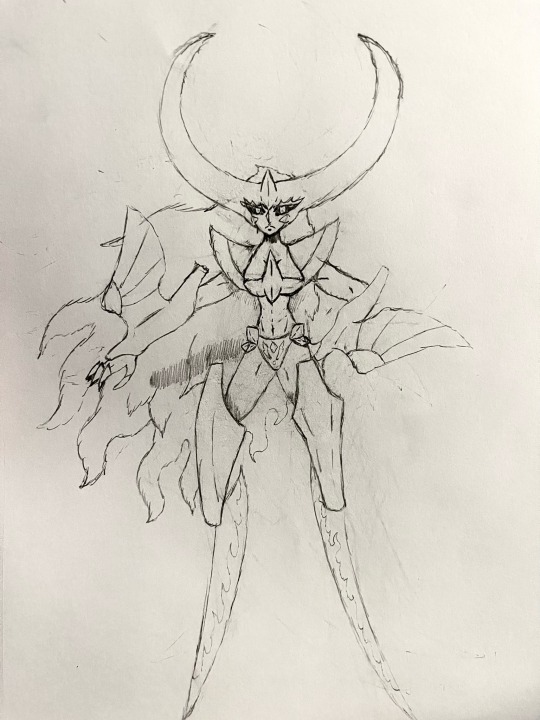
Inanna, the ancient Mesopotamian goddess of war, fertility, beauty, and love. Born from the moon god Nanna, Inanna is young and unruly, constantly trespassing onto other god’s domains. However she’s incredibly strong as the other gods feared her mere presence. Inanna held many lovers, however it is known that she doesn’t treat them with the highest respect, sometimes she’s even accused of abusing them. Despite this when her lover Dumuzid had been murdered she personally travelled to the underworld and brought him back to the world of the living. Her most prevalent role came in the epic of Gilgamesh, wherein Gilgamesh rejected Inanna’s proposition for him to become her new consort. Angered by his decision Inanna sent the bull of heaven to attack Gilgamesh. Gilgamesh however was able to kill the bull, but not without losing his closest companion Enkidu.
Inanna is the first of the many names given to the goddess, the name Ishtar was given to her later on by the Assyrians and the Babylonians. Despite her being a goddess of love and being called the queen of heaven, she was never once depicted by her worshipers as a mother goddess, scant few sources even mention her being a mother at all. Her origin traces back to the Semitic goddesses Astarte and Anat, with Inanna’s war and fertility traits most likely being derived from them. Inanna was also conflated with the Arabian Al-lat, an ancient Arabian mother goddess. Her worship was incredibly popular, as she held more titles and stories dedicated to her than any other god in Mesopotamia, she’s even mention in the Bible. Her cult was also very sexually inclusive, as those outside the binary norm found solace in her worship.
#art#character design#mythology#goddess#deity#fertility god#love god#war god#mesopotamia#mesopitamian mythology#sumerian#sumerian mythology#babylon#babylonian mythology#assyria#assyrian mythology#inanna#ishtar
2 notes
·
View notes
Text
Satan has his candle always tall, constantly flickering and overall pretty unavoidable. I love it honestly.
Anyway, this is just some of the things going on in my practice. I have found that Inanna-Ishtar has reached out, as well as Loki. I am still researching into it all.
I still find myself drawn to Kemeticism, I had done some readings and Hathor, Ra & even Isis came by. Hathor has really made her presence known. But, my race is on the Celtic (I don’t know which part) and Mexican side, I hesitate to work with them. Especially since I hear that Kemeticism is a closed practice, sometimes I hear it’s open. I just don’t want to step on anyone’s toes & potentially disrespect someone’s culture & beliefs.
#pagan#paganism#witchblr#witchcraft#deity work#satanism#inanna#inanna-Ishtar#Ishtar#Loki#dianadeity#artemisdeity#roman pantheon#greek pantheon#kemetism#kemetic#egyptian pantheon#egyptian paganism
6 notes
·
View notes